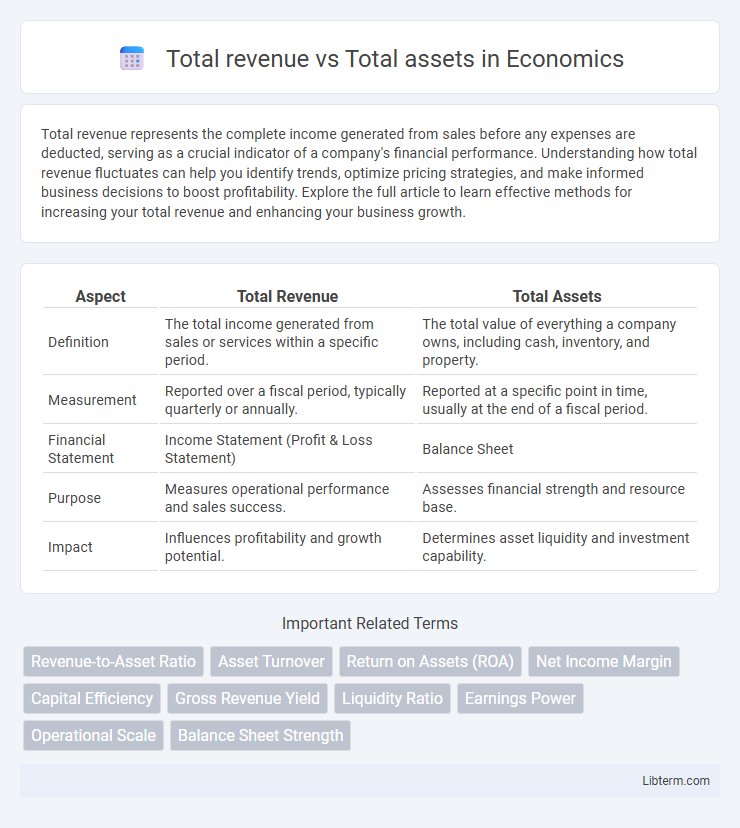Total revenue represents the complete income generated from sales before any expenses are deducted, serving as a crucial indicator of a company's financial performance. Understanding how total revenue fluctuates can help you identify trends, optimize pricing strategies, and make informed business decisions to boost profitability. Explore the full article to learn effective methods for increasing your total revenue and enhancing your business growth.
Table of Comparison
| Aspect | Total Revenue | Total Assets |
|---|---|---|
| Definition | The total income generated from sales or services within a specific period. | The total value of everything a company owns, including cash, inventory, and property. |
| Measurement | Reported over a fiscal period, typically quarterly or annually. | Reported at a specific point in time, usually at the end of a fiscal period. |
| Financial Statement | Income Statement (Profit & Loss Statement) | Balance Sheet |
| Purpose | Measures operational performance and sales success. | Assesses financial strength and resource base. |
| Impact | Influences profitability and growth potential. | Determines asset liquidity and investment capability. |
Introduction to Total Revenue and Total Assets
Total revenue represents the total income generated from a company's core business operations, reflecting its sales performance over a specific period. Total assets encompass everything a company owns, including cash, inventory, property, and equipment, indicating its overall financial strength. Comparing total revenue to total assets provides insights into asset utilization efficiency and operational effectiveness.
Defining Total Revenue: Key Concepts
Total revenue refers to the total income generated from the sale of goods or services before any expenses are deducted, serving as a crucial indicator of a company's operational performance. It includes all sources of income such as sales revenue, service fees, and other related earnings within a specific period. Understanding total revenue is essential for evaluating profitability, operational efficiency, and comparing against total assets to assess asset utilization and financial health.
Understanding Total Assets: What They Include
Total assets encompass all resources a company owns, including current assets like cash, accounts receivable, and inventory, as well as fixed assets such as property, equipment, and intangible assets like patents. Understanding total assets is crucial for evaluating a company's capacity to generate revenue, as these assets represent the foundation used to produce goods and services. Comparing total revenue to total assets helps measure asset efficiency and overall financial health through ratios like asset turnover.
Differences Between Total Revenue and Total Assets
Total revenue represents the income generated from a company's core business operations within a specific period, reflecting operational performance, while total assets encompass all resources owned by the company, including cash, inventory, property, and equipment, providing a snapshot of financial position at a given time. Total revenue is a flow metric measured over time, whereas total assets are a stock metric measured at a point in time. Understanding these differences is crucial for accurate financial analysis and decision-making regarding profitability versus asset management.
Importance of Total Revenue in Business Analysis
Total revenue serves as a critical indicator of a company's operational efficiency and market demand, directly impacting profitability and cash flow management. Analyzing total revenue alongside total assets enables investors and managers to assess how effectively a company leverages its assets to generate sales, revealing asset utilization and growth potential. High total revenue relative to total assets often signals strong market position and operational scalability, essential factors in strategic business analysis.
Significance of Total Assets in Financial Health
Total assets represent the cumulative value of everything a company owns, providing a snapshot of its financial foundation and capacity for generating revenue. Analyzing total revenue in relation to total assets offers insights into asset efficiency and operational performance, indicating how well a company utilizes its assets to generate income. Strong total assets signify stability and potential for growth, crucial for attracting investment and sustaining long-term financial health.
How Total Revenue and Total Assets Interact
Total revenue and total assets interact by reflecting a company's operational efficiency and asset utilization in generating sales. High total revenue relative to total assets indicates effective asset management and strong revenue-generating capability. Analyzing the asset turnover ratio, which divides total revenue by total assets, provides insights into how well a company leverages its assets to drive revenue growth.
Key Financial Ratios: Revenue-to-Assets Explained
The revenue-to-assets ratio measures a company's efficiency in generating sales from its total assets, calculated by dividing total revenue by total assets. This key financial ratio provides insight into how effectively a firm utilizes its asset base to produce income, with higher ratios indicating better asset productivity. Investors and analysts use this metric to assess operational performance and compare asset utilization across companies within the same industry.
Practical Examples: Total Revenue vs Total Assets
Total revenue measures the income generated from sales or services, while total assets represent the company's resources and holdings at a specific point in time. For example, Amazon reported $524.9 billion in total revenue for 2023, reflecting its sales scale, compared to $420 billion in total assets, indicating investments in infrastructure and technology. Understanding the revenue-to-asset ratio helps investors assess how efficiently a company uses its assets to generate sales.
Conclusion: Strategic Insights for Decision Makers
Total revenue divided by total assets, often referred to as asset turnover ratio, offers critical insights into a company's operational efficiency and asset utilization. A higher ratio indicates effective revenue generation from existing assets, guiding decision makers in optimizing capital allocation and improving investment returns. Strategic focus on enhancing this metric supports sustainable growth, risk management, and competitive advantage in financial planning.
Total revenue Infographic

 libterm.com
libterm.com